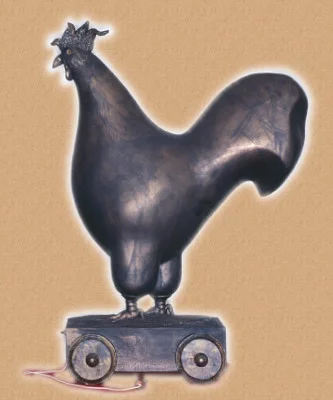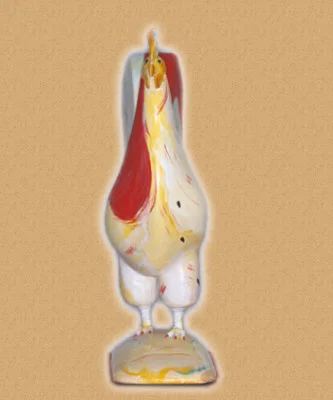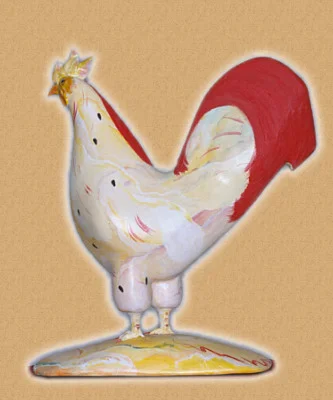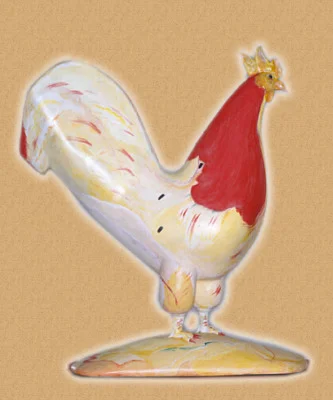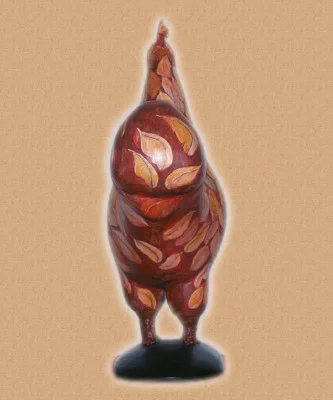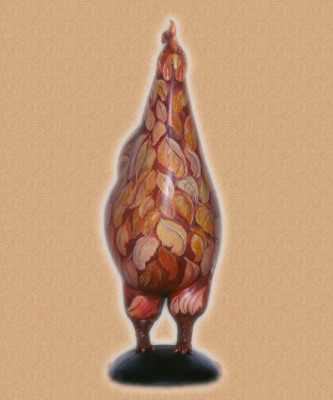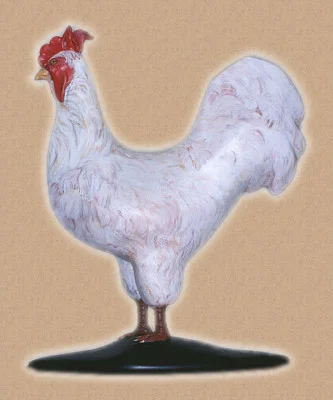About the series
After art school,
I spent several years painting and really missed working with other materials and sculpting. I found that I was becoming very bored painting on flat surfaces. I decided to stop painting for a while and spend some time thinking about what I would like to make. First, I had to ask myself a few questions: Human or animal? Shape? Medium? Paintable? Size? Malleable form?
While I answered these questions, thoughts of childhood, my mother’s influences, and an old Bantam rooster kept entering my thought process. I asked myself: Why is this happening; do I need to address these memories?
I’m glad that I took the time to ponder the past because I began thinking of pullets and cockerels!
Throughout history, the ubiquitous chicken has maintained an important and constant presence in many cultures worldwide. Beyond their role as a food source and a source of income, these humble and unassuming birds show up in religion, music, arts and medicine.
Their influence spans all aspects of our culture. They are a subject of folklore, occult mystery, and sometimes comedy. This multi-dimensional quality, how we see the chicken, is a reflection of ourselves.
The paradox of the unassuming bird and its role reflecting human characteristics makes the form particularly well suited to art. These sculptures combine the important features of the chicken, which allows us to relate and a surface treatment that complements its specific personality.
The sculptures’ three-dimensional form is a canvas on which the qualities inherent in the form are defined and extended through the use of paint, patina, or oxidation.
After years of depicting three-dimensional objects on a two dimensional canvas, I found myself wanting a new surface and shape on which to paint. I found the basic chicken form, with its universal and versatile qualities, a perfect beginning. To provide a suitable painting surface and form and still retain the basic elements of the chicken resulted in a semi-abstracted form.
A combination of metal, wire, paper and acrylic compound were used to create a series of chicken forms. After the basic shape was acquired, several coats of acrylic compound were applied to the surface. It is necessary to sand between each coat of compound—the shape can still be altered minimally at this stage. Three to four coats of gesso are applied to the surface once the acrylic compound is dry.
Each basic form emerged in its semi-abstracted state with a unique personality. Each chicken receives a painted surface reflecting the personality inherent in the body shape and facial form.
Several forms have been selected as basic canvases. These forms have been cast in resin to provide a blank canvas on which to paint. The surface is treated within a range consistent with the personality of the form. Some of the forms have been treated with bronze and steel surfaces and allowed to naturally oxidize. Some forms have been rendered as bronze castings with patina surfaces.
When I began making the Original Chickens I was looking for a way to provide myself with an opportunity to sculpt and paint. I wanted a material that would take the paint in the same manner a canvas would.
Acrylic provided this surface but as I worked on them and continued to have ideas and explore new materials, I found the acrylic was not compatible with some of the surface embellishments and treatments I wanted to work with.
Six shapes were made initially and then molds were created. Some of the cast resin chickens are made using powdered bronze and/or steel. The powder is brushed on the inside surface of the mold before the casting is made and when the resin is poured it becomes fused with the bronze or steel powders.
The surface of the bronze and steel will naturally oxidize when left outdoors. The painted cast resin chickens are not recommended for outdoor use unless it is kept in a sheltered area.
The cast resin provided me with a surface I could manipulate utilizing various materials and create areas of high or low relief on the surface. Having the ability to change the surface treatment and not the overall shape of the individual chicken enables me to make each chicken an original.
The cast resin allows me to produce and offer my work at an affordable price, in doing so I can reach a larger audience.
On one level, there is a pleasing form of the semi-abstracted chicken presented with its surface treatment. The personalities and roles depicted by the sculptures are human and tell us something about ourselves.
My quest for a three-dimensional canvas has been an evolutionary process. The journey has been one of frustration, education, and delight. My chickens have made me smile and have fed (satisfied) my desire to sculpt and paint. I hope people will enjoy them as much as I have enjoyed the process of making them.


